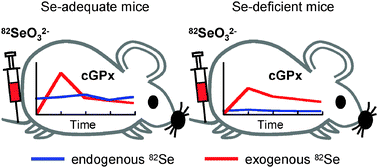The selenoprotein, cellular glutathione peroxidase (cGPx), has an important role in protecting organisms from oxidative damage through reducing levels of harmful peroxides. The liver and kidney in particular, have important roles in selenium (Se) metabolism and Se is excreted predominantly in urine and feces. In order to characterize the dynamics of these pathways we have measured the time-dependent changes in the quantities of hepatic, renal, urinary, and fecal Se species in mice fed Se-adequate and Se-deficient diets after injection of 82Se-enriched selenite. Exogenous 82Se was transformed to cGPx in both the liver and kidney within 1 h after injection and the synthesis of cGPx decreased 1 to 6 h and continued at a constant level from 6 to 72 h after injection. The total amount of Se associated with cGPx in mice fed Se-deficient diets was found to be less than in mice fed Se-adequate diets. This finding indicated that cGPx synthesis was suppressed under Se-deficient conditions and did not recover with selenite injection. Excess Se was associated with selenosugar in liver and transported to the kidney within 1 h after injection, and then excreted in urine and feces within 6 h after injection. Any excess amount of Se was excreted mainly as a selenosugar in urine.

You have access to this article
 Please wait while we load your content...
Something went wrong. Try again?
Please wait while we load your content...
Something went wrong. Try again?


 Please wait while we load your content...
Please wait while we load your content...